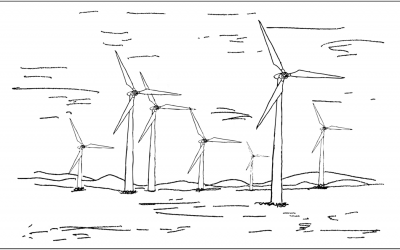What is Wind farm maintenance?
Wind farm maintenance is any process used to keep wind turbines in consistent working order. Maintenance workers on wind farms lubricate moving parts—such as gearboxes and bearings—check connections within the system, and resolve any major issues that may develop.

In the U.S., the cost of operations and maintenance on wind farms in 2016 ranged between $42,000 and $48,000 per MW. As a form of power generation, it’s absolutely vital that wind farms be kept in optimum working condition to streamline those costs. For this reason, regular preventive maintenance is commonly used.
Types of wind farm maintenance workers
The majority of personnel are maintenance technicians. Supervisors may also be hired to oversee maintenance operations on turbines.
Wind turbine technician
Wind turbine technicians are also referred to as “windtechs” in the industry. They handle the installation and maintenance of wind turbines, and they often work at heights in excess of 300 feet. They are in high demand due to the rapid growth of wind-based power plants, making their job prospects very good for the next decade.
Maintenance supervisor
Wind farms employ maintenance supervisors to oversee maintenance technicians and handle numerous administrative matters, such as scheduling and reporting. Supervisors may also assist with repairing and maintaining wind turbines when needed
Some examples
A wind farm with about 300 turbines would need numerous windtechs to keep everything in peak working condition. During the first five years of the wind farm’s operation, the turbines would all be under warranty, but after that point, the burden of maintenance falls on the wind farm owner.
To keep up with their maintenance tasks, the wind farm utilizes both preventive and predictive maintenance processes. Sensors located at key points on each turbine send various types of data back to the wind farm’s maintenance team. This data includes information on lubrication levels, vibration, temperatures, and foundation displacement, all of which can be used to plan maintenance. For instance, if the wind eddy sensors show too much vibration in the turbine shaft, it can indicate the shaft has run too far out of place and needs to be realigned.
In addition to the sensor data, the wind farm schedules regular lubrication and maintenance checks to keep each turbine in top working order. Lubrication checks are scheduled every six months, and the maintenance team uses CMMS software to keep track of when each of their 300 turbines has been serviced. When a turbine is due a maintenance check, the system sends them a notification, and they schedule a technician to handle it.
Entities that use wind farm maintenance
- Electric power providers: Electric power companies use wind farms to generate electricity. These companies employ the largest number of wind turbine technicians, and they are primarily responsible for the maintenance of the wind farms they use.
- Industrial equipment repair services: Some wind farms utilize industrial repair services. These independent service providers specialize in power systems maintenance, and they often work under contract with power supply companies.
- Utility system construction: Utility system construction companies build and maintain the infrastructure used to generate and distribute power. In many cases, this includes wind farms, and they will employ windtechs to maintain the assets they construct.
Certifications and training
Community colleges and universities provide training programs for wind turbine technicians. These programs vary depending on the institution, but all aim to prepare their students for working on wind farms. Coursework generally covers industrial safety, equipment maintenance, and technology skills.
Dedicated certification programs are fairly sparse for wind farm maintenance, but two organizations provide certifications specific to this field.
- GE’s Wind Technician Certification Program: GE has partnered with Excelsior College to provide wind turbine technician training for their employees. Employees in this program can earn college credit toward a Bachelor’s degree.
- ETA International Small Wind Installer Certification: The Electronics Technicians Association, International (ETA International) has created numerous certification programs for those working in the renewable energy industry. They currently have only one certification program for wind turbine technicians, which is the SWI1 (Small Wind Installer – Level 1) certification.
Contact
- Add: 308 Le Thanh Tong, Ngo Quyen District, Hai Phong City
- Hotline: (+225) 3767758 | (+84) 913 244 367
- Mail: info@minhhoangcrane.com.vn


